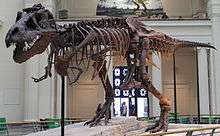Peter Larson
.jpg)
Peter Lars Larson (born 1952) is an American paleontologist, fossil collector, and president of the Black Hills Institute of Geological Research. He led the team that excavated "Sue", the largest and most complete specimen of Tyrannosaurus rex found to date, and has published numerous scientific and popular works on dinosaur paleontology. He is criticized by some academic paleontologists for his commercial enterprises and support of private collections.[1]
Early life and education
Peter Larson grew up a on ranch near Mission, South Dakota. He began rock hunting at the age of four on his parent's ranch. He attended the South Dakota School of Mines to study paleontology. He graduated with a bachelors degree in 1974. Shortly after graduating college he started Black Hills Minerals.
Career

Larson founded what eventually became the Black Hills Institute in 1974.[2] Partners Robert Farrar and (Larson's brother) Neal Larson later joined the company. In 1990, Larson led the excavation of the Tyrannosaurus rex skeleton later named "Sue". With only a bachelor's degree in geology,[1] Larson has written and co-authored numerous publications on dinosaurs, has excavated more T. rex skeletons than any other paleontologist,[3] and his organization's work on excavation and preparation of fossils has been recognized by paleontologists Robert Bakker, Philip Currie, Phillip Manning, and Jack Horner for its quality.[1][4] He was one of the first to work with T. rex bone pathologies, has worked to uncover sexual dimorphism in the chevron length of T. rex, and argues that the controversial tyrannosaurid Nanotyrannus is not a juvenile T. rex, as some claim.[5]
In 1992, Larson's team helped to discover second largest Tyrannosaurus rex Stan. Larson, along with paleontologist Kenneth Carpenter, edited the scholarly text Tyrannosaurus Rex, the Tyrant King. Larson and his ex-wife Kristin Donnan wrote the book Rex Appeal, which relates the story of how the U.S. Government took possession of the "Sue" T. rex skeleton following its excavation, and Bones Rock!, a children's book about the history of paleontology and requirements on how to become a palaeontologist.[1]
In 2013 Larson and colleagues began excavating at a site located in Wyoming, US containing the remnants of three nearly complete skeletons of Triceratops.[6]
Federal lands dispute
Following a result of the government seizure of property at the Black Hills Institute, from charges pertaining to paleontological work unrelated to the "Sue" T. rex find,[7] Larson was remanded to the federal penitentiary at Florence, Colorado for his conviction of two felonies and two misdemeanors,[8] charges which some considered politically motivated.[4] The felonies involved the "failure to fill out forms," which resulted from contested instructions from the judge. The trial record shows that the judge told the jury to ignore testimony from the government's own customs witnesses, testimony that normally would have resulted in acquittals in these charges.[9] Richard Howard Battey sentenced Larson two years in federal prison despite the maximum sentence being only six months. In 2015, South Dakota law makers have petitioned Barack Obama for a formal full pardon of Larson.[10]
Legacy
Larson has developed a controversial standing among some academic paleontologists who object to his organization's commercial selling of fossils and his lack of pedigree,[1][2] yet Robert Bakker has backed Larson as a responsible paleontologist.[8] To date, he has discovered the most tyrannosaurus rex skeletons and is considered by some to have made some of the greatest paleontological discoveries of all time.
Selected works
Journal articles
- Larson,P and Frey,E. "Sexual Dimorphism in the Abundant Upper Cretaceous Theropod, T. rex." Journal of Vertebrate Paleontology 12, Abstract 96, 3 September 1992.
- DePalma, R. A.; Burnham, D. A.; Martin, L. D.; Rothschild, B. M.; Larson, P. L. (2013). "Physical evidence of predatory behavior in Tyrannosaurus rex". Proceedings of the National Academy of Sciences. 110 (31): 12560–12564. doi:10.1073/pnas.1216534110.
Popular books
- Larson, P. and Donnan, K. "Rex Appeal". Montpelier, VT: Invisible Cities Press, 2002.
- Larson, P. and Carpenter, K. "Tyrannosaurus Rex, the Tyrant King (Life of the Past)". Indiana University Press, 2008.
- Larson, Peter; Kristin Donnan (2004). Bones rock! Everything you need to know to become a paleontologist. Montpelier, Vt.: Invisible Cities Press. ISBN 193122935X.
See also
- Sue Hendrickson, discoverer and namesake of the T.rex "Sue"
- Dinosaur renaissance
- Paleontology in South Dakota
References
- 1 2 3 4 5 Mullen, William (January 21, 2003). "Bones of contention: Academics and commercial fossil hunters may never settle their differences". Chicago Tribune.
- 1 2 Rooney, Brian (Nov 13, 2007). "Racing Against Time and Weather for Dinosaur Bones". ABC News. Retrieved 26 April 2014.
- ↑ Alden, John (August 11, 2002). "'Rex Appeal' - one historic fossil, three stories". The Baltimore Sun.
- 1 2 Browne, Malcolm W. (July 21, 1992). "A Dinosaur Named Sue Divides Fossil Hunters". New York Times.
- ↑ Switek, Brian (23 October 2013). "(News Feature) Palaeontology: The truth about T. rex". Nature. 502 (7472): 424–426. doi:10.1038/502424a.
- ↑ Smith, Matt (June 4, 2013). "Triceratops trio unearthed in Wyoming". CNN. Retrieved 18 April 2014.
- ↑ Kjærgaard, Peter C. (June 2012). "The Fossil Trade: Paying a Price for Human Origins". ISIS. 103 (2): 340–355. JSTOR 10.1086/666365.
- 1 2 Browne, Malcolm (February 22, 1996). "Fossil Dealer, Target of Federal Prosecutors, Begins Jail Term". New York Times. Retrieved 18 April 2014.
- ↑ Larson & Donnan, Peter & Kristin (2002). Rex Appeal: The Amazing Story of Sue, the Dinosaur That Changed Science, the Law, and My Life. Invisible Cities Press.
- ↑ Associated Press. "Panel calls for pardon of famous paleontologist credited in discovery of 'Sue' the T. rex". Chicago Tribune.
External links
- Collaborator Profile, University of Manchester Paleontology
- Peter Larson at the Internet Movie Database
- Black Hills Institute of Geological Research Inc. website